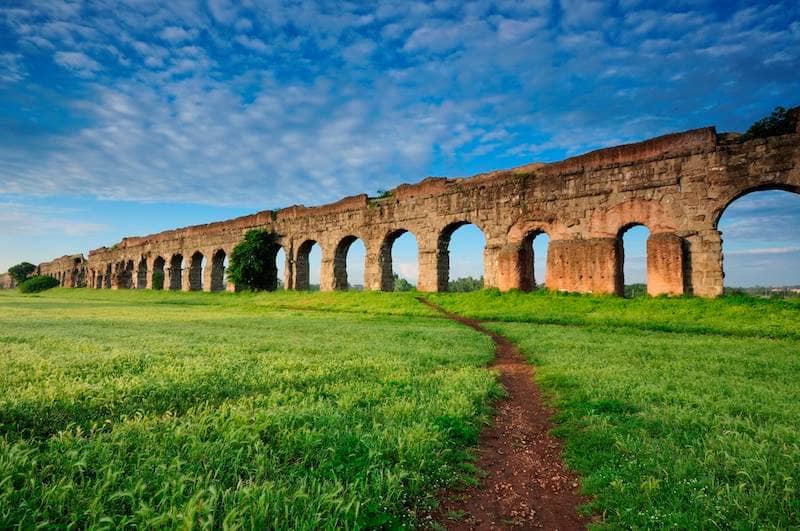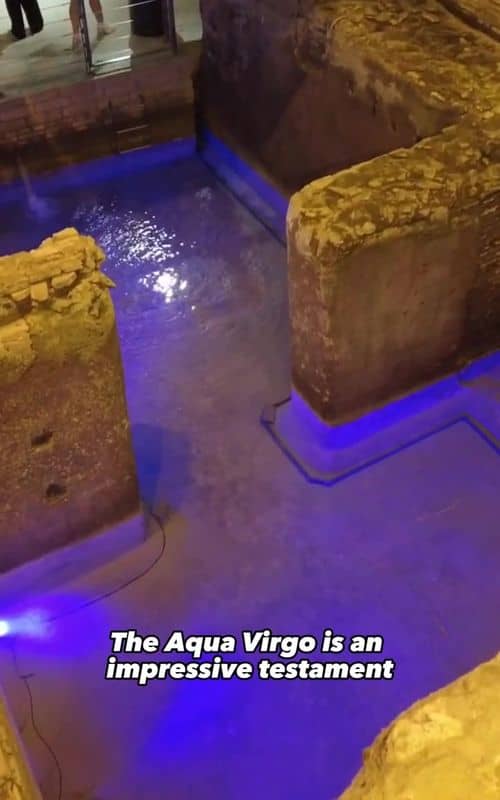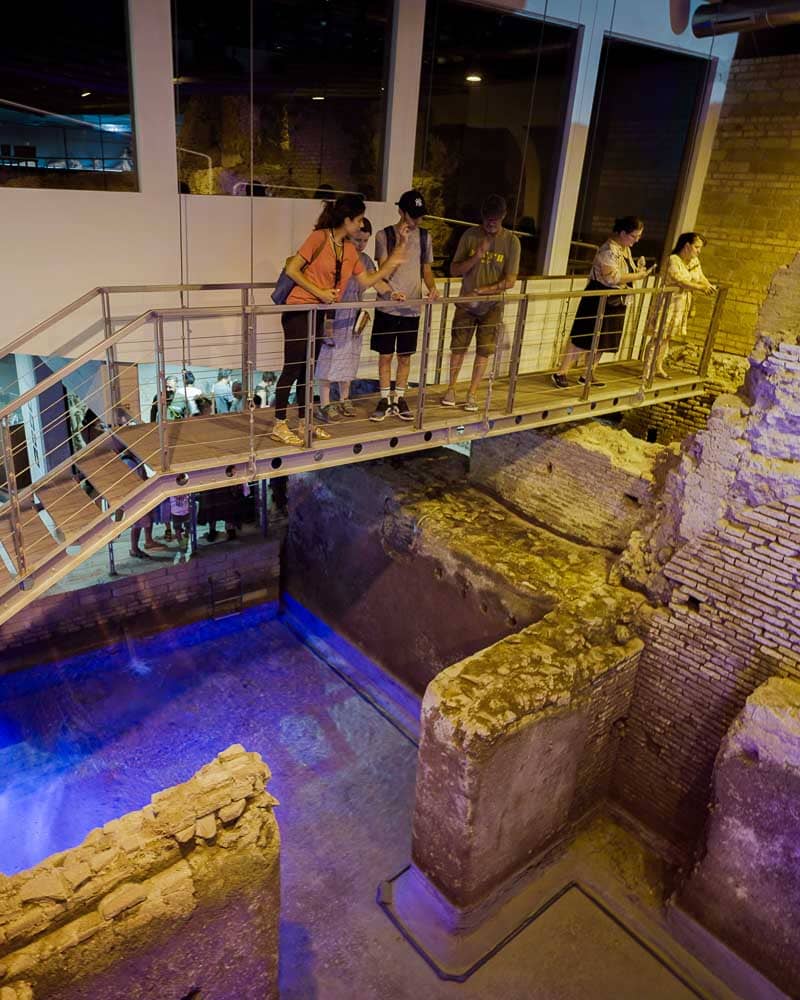Pantheon and Aqua Virgo Rome
Discover the Aqua Virgo, an ancient Roman aqueduct still in use, feeding Rome's most famous fountains. A unique historical gem.

Highlights
Must-see attractions

Social
From TikTok & Reddit
Best Time
Fewer crowds, peaceful viewing
Pantheon and Aqua Virgo Rome
Best Time
Fewer crowds, peaceful viewing

Highlights
Must-see attractions
Discover the Aqua Virgo, an ancient Roman aqueduct still in use, feeding Rome's most famous fountains. A unique historical gem.
"Unbelievable to see the architectural and engineering it took over 2000 years ago!"
🎯 Access the Aqua Virgo
Enter the Rinascente Department Store on Via del Tritone and head to floor -1 for the aqueduct exhibit. :ticket:
🚶♂️ Peaceful Alternative
Skip the Colosseum crowds for a calm walk along ancient ruins. It's free and accessible! :athletic_shoe:
Highlights
Discover the most iconic attractions and experiences

Aqua Virgo Underground
Rinascente Department Store Basement
Witness an ancient Roman aqueduct, still functional after 2000 years, displayed with educational projections.

Trevi Fountain's Secret
Trevi Fountain
See where the Aqua Virgo's water culminates, feeding one of Rome's most spectacular and iconic Baroque fountains.
Pantheon Fountain
Piazza della Rotonda
Appreciate the fountain in front of the Pantheon, a testament to the continuous flow of water from the ancient Aqua Virgo.
Plans like a pro.
Thinks like you
Planning Your Visit
Aqua Virgo: A Hidden Gem
Pantheon's Water Source
Best Times
Insider Tips
from TikTok, Instagram & Reddit
🎯 Access the Aqua Virgo
Enter the Rinascente Department Store on Via del Tritone and head to floor -1 for the aqueduct exhibit. :ticket:
🚶♂️ Peaceful Alternative
Skip the Colosseum crowds for a calm walk along ancient ruins. It's free and accessible! :athletic_shoe:
💡 Educational Experience
Enjoy the informative light projections and plaques explaining the aqueduct's history. :iphone:
☕️ Rooftop Break
After your visit, grab a bite and enjoy Rome's views from the Rinascente rooftop food area. :coffee:
Virgo Aqueduct still working since 19 a.C.
Tips
from all over the internet
🎯 Access the Aqua Virgo
Enter the Rinascente Department Store on Via del Tritone and head to floor -1 for the aqueduct exhibit. :ticket:
🚶♂️ Peaceful Alternative
Skip the Colosseum crowds for a calm walk along ancient ruins. It's free and accessible! :athletic_shoe:
💡 Educational Experience
Enjoy the informative light projections and plaques explaining the aqueduct's history. :iphone:
☕️ Rooftop Break
After your visit, grab a bite and enjoy Rome's views from the Rinascente rooftop food area. :coffee:
What Travellers Say
Reviews Summary
Visitors are consistently impressed by the Aqua Virgo's historical significance and the unique experience of seeing a functional ancient aqueduct within a modern department store. The educational displays and the connection to iconic fountains like the Trevi are highly praised, offering a peaceful and insightful alternative to more crowded attractions. Some find the location unexpected, but the overall experience is deemed educational and worthwhile.
"Enter through Rinascente Department Store (Via del Tritone, 61, 00187 Roma RM, Italy) and go down to floor -1. Cool informational light projection onto the aqueduct inside the basement of the store. Nice area to sit down and watch in the Jewel Market."
Eric Roosden
"I recommend walking the aquaduct over visiting the colleseeum. Visit the outside of the collesum and get your selfie but going inside is just a mosh pit. Aquaduct is a calm peaceful walk among ancient ruins without the crowd. Also this a free open public park easily accessible by metro."
David T
"Unbelievable to see the architectural and engineering it took over 2000 years ago"
Jr Hawkins
What People Like
What People Dislike
Frequently Asked Questions
🚇 🗺️ Getting There
The most unique access point is through the Rinascente Department Store at Via del Tritone, 61. Take the elevator or stairs down to floor -1 to find the exhibit. It's easily reachable by public transport, with several bus lines stopping nearby.
Yes, the Aqua Virgo aqueduct historically supplied water to the area around the Pantheon, including its fountain. You can see the direct connection when visiting both sites.
While the main underground exhibit is within the department store, the aqueduct's water flows through various parts of Rome, feeding famous fountains. The experience is more about understanding its engineering and historical significance.
The Rinascente is centrally located. You can take a bus to stops like 'Tritone/Fontana di Trevi' or 'Barberini' and it's a short walk. The metro Line A station 'Barberini' is also a viable option.
Street parking in this central Rome area is very limited and expensive. It's highly recommended to use public transportation or a taxi to reach the Rinascente. There are underground parking garages nearby, but they can be costly.
🎫 🎫 Tickets & Entry
Accessing the underground exhibit of the Aqua Virgo within the Rinascente Department Store is generally free. It's part of the store's amenities and historical displays.
The exhibit follows the opening hours of the Rinascente Department Store. It's typically open during regular business hours, but it's always best to check the store's official website for the most up-to-date information.
Compared to major Roman attractions, the Aqua Virgo exhibit is usually much less crowded, offering a more peaceful experience. Weekday mornings tend to be the quietest.
The underground exhibit is only accessible during the department store's operating hours. However, you can see fountains fed by the Aqua Virgo, like the Trevi Fountain, beautifully illuminated at night.
While there aren't formal 'tours' in the traditional sense, the Rinascente store provides excellent informational displays and projections that educate visitors about the aqueduct's history and engineering.
🎫 🏛️ Onsite Experience
You'll see a preserved section of the ancient Aqua Virgo aqueduct, illuminated with informative light projections and historical plaques detailing its construction and function. It's a fascinating glimpse into Roman engineering.
Yes, the visual displays and the sheer age of the aqueduct can be captivating for children. It offers a more manageable and less overwhelming historical experience than larger sites.
Most visitors spend around 30-45 minutes exploring the exhibit, reading the information, and watching the projections. It's a concise yet impactful visit.
Photography is generally permitted within the exhibit area, allowing you to capture the impressive ancient stonework and the modern light displays.
Besides the Aqua Virgo exhibit, you can explore the store's various levels of fashion and home goods. Don't miss the rooftop terrace for stunning panoramic views of Rome and a great dining experience.
🎫 ⛲ Fountains Fed by Aqua Virgo
The Aqua Virgo is famously the water source for the Trevi Fountain. It also supplies the fountain in Piazza Navona (Fontana dei Quattro Fiumi) and the fountain in front of the Pantheon.
The Aqua Virgo aqueduct terminates near the Trevi Fountain, providing the water that cascades through its magnificent Baroque sculptures. It's a direct link between ancient engineering and a modern masterpiece.
The water from the Aqua Virgo is still used for public fountains, and while it's treated, it's generally not recommended to drink directly from them. However, the aqueduct's continuous flow is a marvel of Roman infrastructure.
Built in 19 BC by Marcus Vipsanius Agrippa, the Aqua Virgo is one of Rome's oldest aqueducts and remarkably, the only one still in operation today, a testament to Roman engineering prowess.
While the main accessible exhibit is in the Rinascente, remnants and visible channels of the Aqua Virgo can be found in various locations throughout Rome, often integrated into the urban landscape or visible in archaeological sites.
For Different Travelers
Tailored advice for your travel style
👨👩👧 Families with Kids
Pro-tip: Combine the visit with a trip to the Trevi Fountain (where the water ends up!) and the Pantheon's fountain. These iconic spots are sure to capture kids' imaginations, and knowing they're fed by an ancient aqueduct adds an extra layer of wonder. The Rinascente's rooftop also offers a fun break with food and views.
🏛️ History Buffs & Engineering Enthusiasts
Beyond the exhibit, tracing the aqueduct's path to the Trevi Fountain and other fountains it supplies offers a deeper appreciation for its scale and impact. Consider looking for other visible remnants or reading up on its history beforehand to maximize your understanding of this incredible feat of engineering.
🚶♀️ Solo Travelers & Budget Explorers
Combine your visit with exploring the surrounding area, including the Pantheon and the Trevi Fountain, which are also free to admire from the outside. The Rinascente's rooftop offers affordable food options with incredible views, making it a budget-friendly way to enjoy Rome.
Deep Dives
In-depth insights and expert knowledge
The Engineering Marvel of Aqua Virgo
What makes the Aqua Virgo particularly special is its direct connection to some of Rome's most iconic water features. It is the primary source of water for the world-famous Trevi Fountain, a Baroque masterpiece that draws millions of visitors annually. It also feeds the Pantheon's fountain and the Fountain of the Four Rivers in Piazza Navona, seamlessly blending ancient infrastructure with Renaissance and Baroque artistry. This continuous flow of water underscores the enduring legacy of Roman innovation and its impact on the city's aesthetic and daily life.
For visitors, experiencing the Aqua Virgo offers a unique perspective on Rome's history. The accessible section within the Rinascente Department Store provides an intimate look at the ancient stonework, enhanced by modern educational displays. It's a chance to appreciate the sheer scale of Roman public works and understand how they shaped the city we see today, often in unexpected and accessible ways.
Experiencing the Aqua Virgo: Beyond the Department Store
Beyond the Trevi Fountain, the Aqua Virgo's legacy is visible in the Pantheon's Piazza della Rotonda, where a fountain stands before the ancient temple, a constant reminder of the aqueduct's historical role. Similarly, the Fountain of the Four Rivers in Piazza Navona, a masterpiece by Bernini, is also supplied by this ancient water source. These fountains are not just decorative; they are living monuments to Roman ingenuity and the enduring power of its infrastructure.
For those interested in a more in-depth exploration, seeking out other visible remnants of the Aqua Virgo can be a rewarding adventure. While not always as grand as the underground exhibit, spotting sections of the aqueduct integrated into the urban fabric or preserved in archaeological areas offers a deeper connection to Rome's ancient past. It transforms a simple sightseeing trip into a historical treasure hunt.
Social
from TikTok, Instagram & Reddit